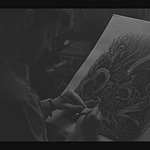Zdzisław Beksiński (1929-2005) was a Polish artist whose life was marked by both extraordinary artistic achievement and profound personal tragedy. Born in Sanok, Poland, Beksiński's early life was disrupted by World War II, during which he may have been given a false birth date to avoid deportation to Germany for forced labor. Despite his passion for film, family pressure led him to study architecture. In 1951, he married Zofia Helena Stankiewicz, who would become his muse and remain his wife until her death in 1998.Beksiński had no formal artistic training. After graduating, he worked as a construction supervisor and later as a bus designer for Autosan—jobs he disliked. During this time, he began exploring various art forms, initially sculpting with materials from construction sites. By 1957, he had established himself in art photography, becoming a member of the Association of Polish Art Photographers and exhibiting internationally.His artistic breakthrough came in 1964 when his exhibition at Warsaw's Old Orange House Gallery sold out completely. This success allowed him to leave his job at Autosan to pursue art full-time. By the 1970s, he had transitioned to painting dark, dreamlike visions in what he called his "fantastic period."In 1977, Beksiński moved to Warsaw, ceremonially burning works he didn't wish to take with him. His four-room apartment became his studio for the next three decades, where he created while listening to 19th and 20th-century composers.Though he worked with Parisian art dealer Piotr Dmochowski to promote his work internationally, Beksiński himself showed little interest in publicity or the art world. He eventually ended this relationship in 1994, preferring to work with the Sanok Historical Museum, which became instrumental in preserving and promoting his legacy.Beksiński's personal life was marked by tragedy. His wife died from an aortic aneurysm in 1998, followed by his son Tomasz's suicide on Christmas Eve 1999. Left alone, he continued working on paintings and digital art until his murder on February 21, 2005, by his caretaker's teenage son.The Sanok Historical Museum, which Beksiński had named his sole beneficiary, received all his remaining works. Today, it houses the world's largest collection of his art, which continues to influence contemporary films, music, and video games. Among his admirers is Oscar-winning director Guillermo del Toro, who praised Beksiński's ability to evoke "the process of decay and the ongoing struggle for life."
******
This podcast is devoted to the life, art, critique, analysis, and legacy of Zdzisław Beksiński, a Polish painter, photographer, and sculptor (1929-2005).
This podcast consists of five main episodes:
Part 1 – Life
Part 2 – Art Photography, Sculptures, and Drawings
Part 3 – Paintings and Computer Generated Works
Part 4 – The Critique, the Analysis, and the Legacy
Part 5 – In his own words - Beksiński by Beksiński
The text is based on Wieslaw Banach's essay, used with permission from the Historical Museum in Sanok, Poland, and Bosz Publishing House. All artwork copyrighted by the Historical Museum in Sanok. Text read by Phil Schoen. All music was composed and edited by Andrea Centazzo. All rights reserved.
For more, please visit www.beksinski.gallery
Beksiński’s albums from Bosz Publishing House are available from Amazon.com/bosz








Share this post